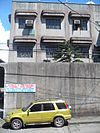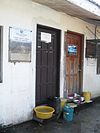- Malabon
-
City of Malabon
Lungsod ng Malabon— City — 
SealMap of Metro Manila showing the location of Malabon Map of Metro Manila showing the location of Malabon Coordinates: 14°39.75′N 120°57.4′E / 14.6625°N 120.9567°ECoordinates: 14°39.75′N 120°57.4′E / 14.6625°N 120.9567°E Country Philippines Region National Capital Region District Lone District of Malabon City Barangays 21 Cityhood May 7, 2001 Area - Total 19.76 km2 (7.6 sq mi) Population (2007) - Total 363,681 - Density 18,404.9/km2 (47,668.5/sq mi) Time zone PST (UTC+8) The City of Malabon is one of the cities and municipalities that make up Metro Manila in the Philippines. Located just north of Manila, the city has a population of 363,681 as of 2007. It is primarily a residential and industrial town and is one of the most densely populated cities in the metropolis. It has a total land area of 19.714 square kilometers.
Malabon is part of the sub-region of Metro Manila informally called CAMANAVA. CAMANAVA consists of Caloocan City, Malabon City, Navotas City, and Valenzuela City. Caloocan lies to the south and east, Navotas to the west, and Valenzuela to the north. Malabon also borders the town of Obando in the province of Bulacan to the northwest.
Contents
History
Malabon, per legend, came from the words maraming labong which means "plenty of labong", the edible bamboo shoots. Originally called the town of Tambobong, Malabon was founded as a “Visita” of Tondo by the Augustinian friars on May 21, 1599 and remained under the administrative jurisdiction of the province of Tondo from 1627 to 1688.
The newspaper La Independencia was first printed in Malabon’s Asilo de Huertanos, where orphaned children due to a plague in 1882 were housed.[1][2]
Malabon was officially made a municipality of the newly-created province of Rizal on June 11, 1901 by virtue of Philippine Commission Act No. 137.[3] When Act No. 942 was promulgated, Malabon was merged with Navotas under a new government.[4] On January 16, 1906, Act No. 1441 separated Malabon from Navotas into two distinct municipalities of the Rizal province. The first Mayor of Malabon was Don Agustin Salamante, a Spanish mestizo originally from Cavite.
For 70 years, Malabon was a municipality of Rizal, until November 7, 1975, by virtue of Presidential Decree No. 824, when Malabon became a part of Metropolitan Manila or the National Capital Region. Malabon became a city on April 21, 2001, under Republic Act No. 9019 when Malabon was 407 years old.
Politics and government
Representative Lone District of Malabon[5]
- Hon. Josephine Lacson-Noel [6]
Chief Executive and Council
Councilors First District
Maricar Torres, Ian Emmanuel Borja, Jaime Dumalaog, Payapa Ona, Ma. Anna Lizza Yambao, Edwin Gregorio Dimagiba
Second District Councilors
Diosdado Cunanan, Eduardo Nolasco (+)Edward dela Cruz,[9] Fortunato Espiritu, Edralin Yanga, Rufino Bautista [10]
On April 21, 2008, Malabon City’s newly-constructed 11-storey city hall building along F. Sevilla Blvd. in Barangay San Agustin, was inaugurated by Gloria Macapagal-Arroyo on Malabon’s 7th City anniversary. It was dubbed as a “potential business center of the city,” a one-stop shop for government transactions, due to its state-of-the-art facilities such as 3 high-speed elevators and the new city hall building and its offices' “digital system.”[11][12]
Heritage houses
Malabon houses several old homes of historical value: the Dionisio family home, Rivera house, Villongco house, Luna house, the Martinez house, Chikiamco house, the Rojas-Borja house, the Santos-Lapus house, the Luna house and Pantaleon Bautista house, SyJuco (formerly Gaza) house, and the Raymundo house considered to be the oldest located at Cayetano Arellano Street. Other old but well preserved heritage houses in Malabon include the Asilo de Huertano, the Paez House, and the Nepomuceno House.[13]
Local Venice, industry and culture
The city is tagged as the Local Venice, due to year long floods and gradual sinking. The City of Malabon is a place famous for its Pancit Malabon and its predominantly Atlantic ambience. It is also famous for other variety of foods, such as puto sulot, puto bubong, sapin-sapin, broas, bibingka and the camachile. The culinary delights are abundant in its specialty eateries such as the Nanay’s Pancit Malabon, Rosy’s Pancit Malabon, the Pescadores Restaurant, and the Balsa sa Niugan, a floating restaurant with 350 seats, And also you can find "Steakside" a famous fast food restaurant which serves East meets West cuisine with a local twist using only fresh local ingredients that you can find in Malabon City, located at Concepcion Malabon. It is also known for the Bulungan at Tanong Market, the "bulungan" system or whispered bidding in fish trading.[14]
Other Malabon industries include sugar refinery, patis making, cigar making, fishing and Ilang-ilang trees flower extract production where the distilled perfume is exported. Its most famous festival is the "Pagoda-Caracol", a fluvial procession with street dancing to commemorate the Feast of Our Lady of Immaculate Concepcion every 8 December.
Barangays
Malabon City is composed of 21 barangays. In 1956, Acacia was created a barrio from the sitio of San Marcelo, which was formerly part of barrio Tugatog.[15]
- Acacia
- Baritan
- Bayan-bayanan
- Catmon
- Concepcion
- Dampalit
- Flores
- Hulong Duhat
- Ibaba
- Longos
- Maysilo
- Muzon
- Niugan
- Panghulo
- Potrero
- San Agustin
- Santolan
- Tañong
- Tinajeros
- Tonsuya
- Tugatog
Religion
Roman Catholicism- Malabon belongs to the Roman Catholic Diocese of Kalookan. Almost 80% of the people here adhere to this religion. The seat of the Bishop of Kalookan in Malabon is in San Bartolome Parish, is one of the oldest Augustinian church in the Philippines dating back to 1700. Today there are seven Roman Catholic Parish in Malabon: San Bartolome, Immaculate Conception, Exaltation of the Cross, San Antonio de Padua, Sacred Heart of Jesus, Immaculate Heart of Mary and Sts. Peter and John.
Iglesia Filipina Independiente-known as the Aglipayan Church; They have one parish belongs to the Diocese of Rizal and Pampanga: The Parish of La Purisima Concepcion, home to the renowned image of the Immaculate Conception that the folks called it "Impong Maria."
Iglesia ni Cristo-Another notable religious group here is the Philippine Based (Church of Christ). They have four locals in Malabon. Lokal ng Panghulo, Lokal ng Tinajeros, Lokal ng Naval, and Lokal ng Malabon.
Members Church of God International- A group led by Bro. Eli Soriano (Ang Dating Daan) they have a small community here (local ng Tugatog)
Malabon International Baptist Church under Bishop Pio Tica, a very active church in tenejeros not only in spiritual upliftment of Malabon but also visible even in the political aspect of the city. Dr. Pio Tica leads Laging May Pag-asa Foundation (LAMPF) and in the creation of Malabon Ministers for Moral Values (MMMV).
Jesus the Living Stone (under JLS Churches & Ministries & in partnership with LAMPF-MMMV) in barangay Panghulo led by Rev. Andy Alcoba, a versatile and talented minister instrumental of having Special Events bringing Filipino Celebrities/Artists in the city of Malabon (City of God).
Education
- The De La Salle Araneta University is the seventh campus of De La Salle Philippines. It was formerly known as the Gregorio Araneta University Foundation which was established in 1946 as the Araneta Institute of Agriculture in Bulacan, then transferred to Malabon the year after. In 1978 it was renamed as the Gregorio Araneta University Foundation. Integration of the university to the DLS System started since 1987 and in 2002 became an official member of the system. The university specializes in Veterinary Medicine and Agricultural Sciences.
- As an agricultural University - Salikneta Farm (formerly known as Saliksik-Araneta)located at the City of San Jose Del Monte, Bulacan. Its total land area is 64 hectares of farm land owned by Gregorio Araneta University Foundation (now known as De La Salle Araneta University). The wide farmland is used for forestry and agricultural operations for student training purposes.
Aside from serving as a laboratory and research facility, an agricultural-forestryecology- tourism-integrated farm complete with recreational facilities such as horse back riding, carabao cart-pulling for passengers, fishing, camping, mini-zoo and conference area is envisioned in Salikneta.
External links
References
- ^ manilastandardtoday.com, Malabon City: A sight of progress
- ^ wikimapia.org, Malabon City Hall
- ^ "An Act Extending the Provisions of the Provincial Government Act to the Province of Rizal". LawPH.com. http://lawph.com/statutes/act137.html. Retrieved 2011-04-12.
- ^ "An Act Reducing the Thirty-two Municipalities of the Province of Rizal to Fifteen". LawPH.com. http://lawph.com/statutes/act942.html. Retrieved 2011-04-12.
- ^ [1]
- ^ [2]
- ^ [3]
- ^ [4]
- ^ [5]
- ^ [6]
- ^ PGMA to inaugurate new 11-storey Malabon City Hall building tomorrow
- ^ Inauguration of the new Malabon City Hall Building
- ^ Inquirer.net, Malabon’s old houses survive time and tide
- ^ paraisophilippines.com, Malabon - The Local Venice
- ^ "An Act to Convert the Sitio of San Marcelo, Municipality of Malabon, Province of Rizal, into a Barrio to Be Known As Barrio Acacia of the Same Municipality and Separating It from the Barrio of Tugatog of the Same Municipality". LawPH.com. http://lawph.com/statutes/ra1498.html. Retrieved 2011-04-12.

Obando, Bulacan Valenzuela City 
Navotas 
South Caloocan  Malabon
Malabon 

South Caloocan  Metropolitan Manila
Metropolitan ManilaCaloocan
Las Piñas
MakatiMalabon
Mandaluyong
ManilaParañaque
Pasay
PasigTaguig
ValenzuelaMetropolitan Manila Development Authority  Cities of the Philippines
Cities of the PhilippinesHighly-urbanized Cities Angeles · Bacolod · Baguio · Butuan · Cagayan de Oro · Caloocan · Cebu · Davao · General Santos · Iligan · Iloilo · Lapu-Lapu · Las Piñas · Lucena · Makati · Malabon · Mandaluyong · Mandaue · Manila · Marikina · Muntinlupa · Navotas · Olongapo · Parañaque · Pasay · Pasig · Puerto Princesa · Quezon City · San Juan · Tacloban · Taguig · Zamboanga
Independent
Component CitiesComponent Cities Alaminos · Antipolo · Bago · Bais · Balanga · Batangas · Batac · Bayawan · Baybay · Bayugan · Biñan · Bislig · Bogo · Borongan · Cabadbaran · Cabanatuan · Cadiz · Calamba · Calapan · Calbayog · Candon · Canlaon · Carcar · Catbalogan · Cauayan · Cavite · Danao · Dapitan · Dasmariñas · Digos · Dipolog · Dumaguete · El Salvador · Escalante · Gapan · Gingoog · Guihulngan · Himamaylan · Iriga · Isabela · Kabankalan · Kidapawan · Koronadal · La Carlota · Lamitan · Laoag · Legazpi · Ligao · Lipa · Maasin · Malaybalay · Malolos · Marawi · Masbate · Mati · Meycauayan · Muñoz · Naga, Cebu · Oroquieta · Ozamiz · Pagadian · Palayan · Panabo · Passi · Roxas · Sagay · Samal · San Carlos, Negros Occidental · San Carlos, Pangasinan · San Fernando, La Union · San Fernando, Pampanga · San Jose · San Jose del Monte · San Pablo · Santa Rosa · Silay · Sipalay · Sorsogon · Surigao · Tabaco · Tabuk · Tacurong · Tagaytay · Tagbilaran · Tagum · Talisay, Cebu · Talisay, Negros Occidental · Tanauan · Tandag · Tangub · Tanjay · Tarlac · Tayabas · Toledo · Trece Martires · Tuguegarao · Urdaneta · Valencia · Victorias · Vigan
Categories:- Metro Manila
- Cities in the Philippines
Wikimedia Foundation. 2010.








